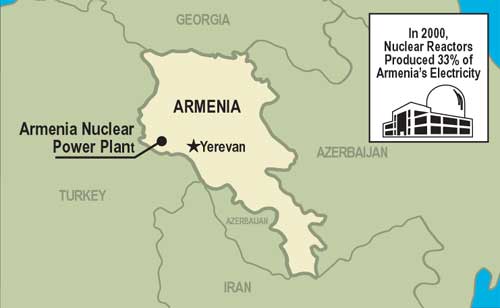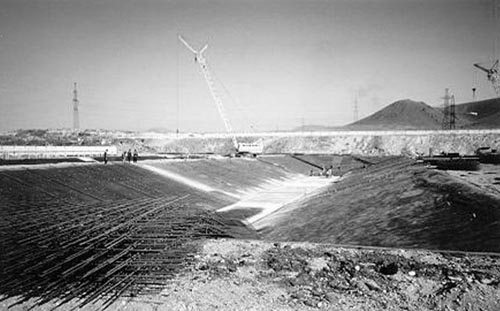3.0 Armenia 

Armenia Unit 2 participates in the cooperative effort to
improve nuclear safety.
One of two reactors at the Armenia nuclear power plant is in operation. The reactors were shut down after a major earthquake in 1988, and there are no plans to restart reactor Unit 1. Unit 2, a VVER-440/230 reactor, resumed operation in 1995. Armenia began working with the United States on cooperative safety projects in May 1996. These projects cover the following areas:
- Personnel Training
- Fire Safety
- Nuclear Service-Water System
- Auxiliary Feedwater System
- Steam Isolation Valves
- Safety Parameter Display System
- Safety Assessments
- Armenian Nuclear Safety Council
Training specialists from the United States and the International Atomic Energy Agency are working with instructors at the Armenia plant to improve personnel training. Instructors are using the Systematic Approach to Training to develop pilot courses. This approach provides a standard framework for identifying training needs, analyzing jobs and their specific tasks, developing course materials based on these analyses, and using teaching methods that combine classroom instruction with the hands-on use of equipment.
Activities Completed
In November 1998, Armenia instructors presented a training course for control room operators at the plant. In 1999, a course for radiation protection technicians was developed and implemented.
Work in Progress
An international team of specialists from the United States and other countries are working with instructors from Armenia to develop courses for maintenance personnel. Training for management and supervisory personnel began in 2000.
The United States is providing equipment and training to reduce the risk of fire at the Armenia plant. Burns & Roe Enterprises Incorporated, the U.S. contractor, is coordinating the fire safety projects.
Activities Completed
In July 1998, the United States provided the Armenia nuclear power plant with 140 fire doors, which were manufactured by the Russian company, Atomremmash. The single fire doors were installed by December 1998, and the remaining double fire doors were installed in 2000.
Workers applied a nonflammable floor coating manufactured by Keeler and Long, Inc., in key safety-related areas of the plant after removing a flammable plastic floor covering. The most critical areas of the plant were completed in September 1998, and additional coverage was completed in 1999. The United Armenian Fund, an Armenian-American charitable organization, arranged for delivery of the floor coating material and the large floor-sanding machine that was used for floor-surface preparation. U.S. specialists trained plant personnel in the techniques needed to properly apply the material.
At the request of the plant, an air charging station was provided in January 2000 for maintaining the self-contained breathing apparatus used by the plant's fire department.
In October 1998, plant workers received detectors and electrical cable needed to begin installation of the U.S.-provided fire detection and alarm system. The Moscow-based firm, ZAO Cerberus, manufactured the system, which was designed by the Russian organization, Atomenergoproekt. The installation and testing of the fire detection and alarm system were completed in December 2000. The system is now operational and running in parallel with the old fire detection system, and U.S. participation in the project is complete. Over the next year, the operation of automatic equipment (e.g., fire dampers) will be transferred from the old system to the new system on a section-by-section basis.
3.3 Nuclear Service-Water System
Nuclear power plants need a cooling system to remove residual heat from the reactor. The reactor at Armenia nuclear power plant has used a cooling tower to remove the heat, but the tower is vulnerable to earthquake damage. U.S. and Armenian specialists worked together to construct a seismically protected, spray-pond cooling system that removes the heat from the plant's safety-related equipment. Burns & Roe is coordinating the U.S. contribution to the project.


Three seismically hardened spray ponds will replace the cooling towers at teh Armenia nuclear power plant.
Pumps in pump houses (right) will circulate cooling water between safety-related equipment in the plant and the spray pond.
Activities Completed
The Armenia plant's deputy director and the construction manager participated in quality assurance training in June 1998. Along with training sessions at the Burns & Roe offices in New Jersey, the two trainees observed quality assurance practices firsthand by visiting a Burns & Roe construction site and the Indian Point nuclear power plant in New York.
Intersigma, a Czech company, manufactured six main water pumps for the service water system. After performing qualification testing, the company delivered the pumps to the plant in October 1998. Workers installed three of the pumps in December 1998 and completed the remaining U.S.-funded activities, including installation of the spray system piping and construction of the three cooling ponds, the pump houses, and the cable tunnels.
In 1999, Russian suppliers delivered electrical cabling, the control system, and a coating material for the spray-pond surface, enabling workers to complete most of the final construction tasks.
At the request of the plant, operation of the system was delayed until an extended outage from August through November 2000. Additional U.S. support was requested in order to complete items not originally included as part of the U.S. project scope. This additional support included funding for various start-up activities such as performing a design review by Atomenergoproekt, completing system modifications identified in the design review, completing the as-built drawings for the system, and completing an environmental and safety analysis report.
During the August through November 2000 outage, workers completed construction of the spray-pond cooling system, connected the system to the plant's emergency service water system, tested the system, and commissioned the system for operation. The new system was placed in operation when the plant restarted after the outage in December 2000.
3.4 Auxiliary Feedwater System
With U.S. support, Armenia will install a seismic-resistant emergency feed-water system. The system will provide emergency cooling water to the reactor's steam generators in case of equipment failure or earthquake damage.
Activities Completed
The United States has provided a diesel-driven pump for use in the backup feedwater system. The United States also has provided a small diesel generator to operate pumping system valves in case of a loss of electricity. The equipment was delivered in early 1999. Burns & Roe is coordinating U.S. participation in the project.
Work in Progress
With U.S. funding, Atomenergoproekt - Nizhny Novgorod is developing an installation design for the backup emergency feedwater system. This system will be installed in a seismically protected area within the Armenia Unit 1 facility (which has been permanently shut down). Flanges to connect the new emergency feedwater system were installed during an outage that ended in December 2000. The balance of the system will be installed during the winter, while the plant is operating. The system will become operational in the spring of 2001.
In a nuclear power plant, main steam isolation valves are designed to isolate the reactor's steam line if a break occurs. Immediate isolation of the ruptured steam line keeps the reactor vessel from overcooling while it is at high pressure-a condition that could damage the vessel and cause leaks. The valves at the Armenia plant, however, cannot close quickly enough to prevent overcooling.
Activities Completed
The United States has provided seven fast-closing, main steam isolation valves to the Armenian nuclear plant. Burns & Roe is coordinating U.S. participation in the valve replacement project. Hopkinson, Ltd. of England manufactured the valves. TACIS, a European Union assistance program, is providing steam generator relief valves for the plant.
During the August through November 2000 outage, the seven new steam isolation valves were installed in the plant (and the original valves were removed), the valve actuators were installed on the isolation valves, and the valves were tested. The automatic actuation system for the valves was installed in the plant, and a series of system demonstration tests was performed. These tests were completed successfully, and the system was placed in operation at the time the plant was restarted in December 2000.
3.6 Safety Parameter Display System
U.S., Armenian, and Russian specialists have developed and installed a safety parameter display system for the Armenia plant. The system was put into operation in May 2000. A safety parameter display system gives plant operators the information they need to control a nuclear plant in the event of an accident. The system enables operators to assess plant conditions rapidly and take quick corrective actions.
In November 1998, Armenia plant staff worked with U.S. specialists from Burns & Roe and Data Systems & Solutions (formerly Science Applications International Corporation) to develop specifications for the safety parameter display system. The system is similar in design to two systems now operating at Russia's Novovoronezh nuclear plant. Specialists from Data Systems & Solutions and ConSyst, a Russian organization, designed the systems for Novovoronezh Units 3 and 4.
Specialists from Data Systems & Solutions developed the final design for the Armenia system, with support from ConSyst. The project team assembled and tested the system at Data Systems & Solutions facilities in the United States. The system was installed in Armenia in early 2000, and the site acceptance tests, which initiated plant operations, were completed in May 2000.
The National Nuclear Security Administration began a project in 2000 to improve the analytical capabilities in Armenia. The United States is providing technical assistance and is transferring safety analysis technology to support the development of independent plant models and analyses for use in evaluating plant safety and promoting safe plant operation during the remaining life of Unit 2. The analyses will be conducted with methods and techniques comparable to those in current use for U.S. nuclear power plants. In this way, the project will achieve the following goals:
- support Armenia with training, analytical tools, and guidance to obtain near-term regulatory compliance
- integrate Armenian safety engineering staff with international activities and experience with VVER safety analysis
- provide a deterministic technical basis of acceptable international quality to support licensing and shutdown decisions
- provide plant configuration documentation important for safe operation and shutdown of the plant.
3.8 Armenian Nuclear Safety Council
The Armenian Council on Nuclear Energy Safety, formed in May 1997, meets periodically to review operational and engineering data and to provide advice on safety improvements at the Armenia nuclear power plant. A U.S. specialist has participated in Council meetings as an appointed member since its inception. As a participant, the U.S. specialist provides insights on plant operational and safety improvement plans based on his experience with U.S. nuclear plants and with other Soviet-designed reactors. He also briefs officials at the Department of Energy, the National Nuclear Security Administration, the Department of State, and the Nuclear Regulatory Commission regarding the Council meetings and provides observations regarding progress on safety improvements at the Armenia nuclear power plant.